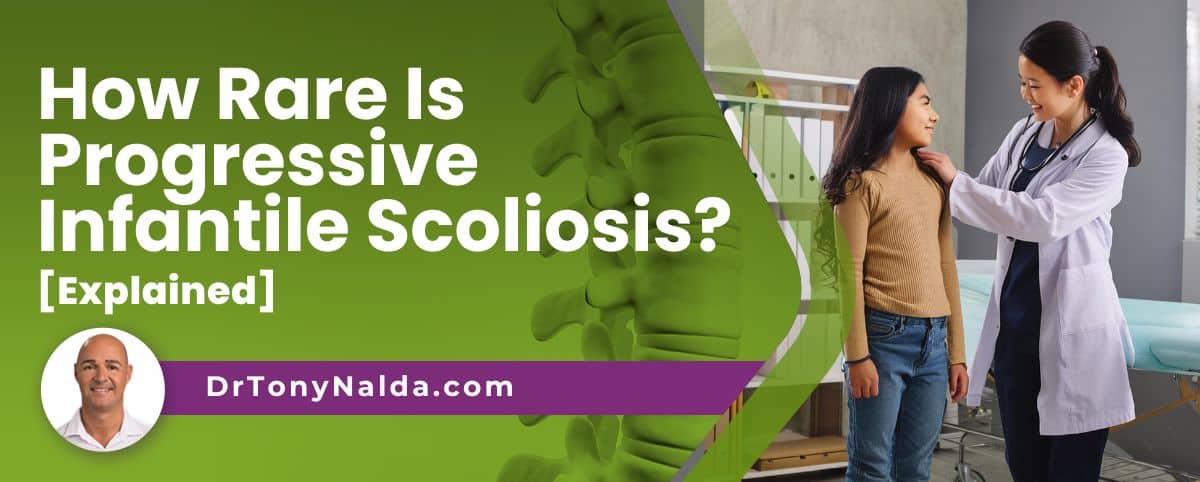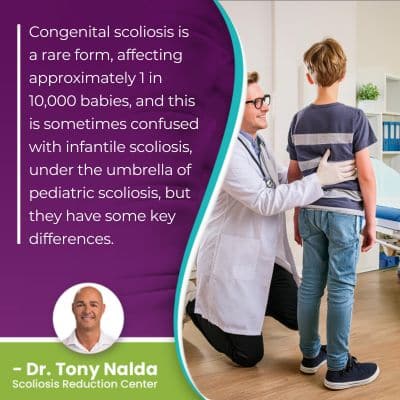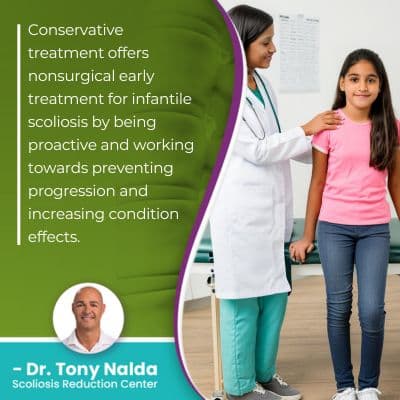How Rare Is Progressive Infantile Scoliosis? [Explained]

Progressive infantile scoliosis can get worse with growth, and in some cases, the condition resolves on its own, without treatment; however, as it's not clear which patients will progress and which won't, there are a number of benefits associated with a proactive treatment approach.
Infantile scoliosis is diagnosed in children between the ages of 6 months and 3 years old; it is a rare type, affecting 1 percent of the population in North America. Not all cases of infantile scoliosis are progressive; some will resolve on their own.
Part of the reason scoliosis is so often described as a complex condition to treat is because no two cases are the same, which is why classifying conditions based on key patient/condition variables is key.
Table of Contents
Diagnosing and Classifying Scoliosis
There are a number of spinal conditions that involve a loss of its healthy curves, and this affects the spine's ability to remain flexible, strong, and able to absorb and distribute mechanical stress evenly during movement.
Scoliosis can be a particularly complex spinal condition to treat for different reasons.
Scoliosis involves the development of an unnatural sideways curvature of the spine that also rotates, making scoliosis a 3-dimensional condition.
Scoliosis also affects all ages, we don't fully understand its etiology, and there are multiple severity levels and types a person can develop; the complex nature of scoliosis necessitates the complete customization of potentially-effective treatment plans.
To diagnose scoliosis, a physical examination is performed, including taking the family history and medical history of the patient, and examining the spine when in a forward bend position (when age appropriate).
A scoliosis X-ray is also needed to see what's happening in and around the spine, to confirm the rotational component, and determine a patient's Cobb angle measurement.
A patient's Cobb angle is known as the gold standard in scoliosis assessment; it involves drawing lines from the tops and bottoms of the curve's most-tilted vertebrae, and the resulting angle is expressed in degrees; the higher the Cobb angle, the more severe the condition, the more in need of treatment it will be, and the more noticeable its effects are also going to be.
Scoliosis ranges widely in severity from mild to very severe scoliosis:
- Mild scoliosis involves Cobb angle measurements of between 10 and 25 degrees
- Moderate scoliosis patients have Cobb angle measurements of between 25 and 40 degrees
- A diagnosis of severe scoliosis is given with Cobb angle measurements of 40+ degrees, and 80+ degrees is considered very-severe scoliosis
Another key classification point is condition type, and this is determined by causation.
Classifying Scoliosis By Type
 Not only does scoliosis affect all ages, there are also multiple different types of scoliosis that are determined by their underlying cause.
Not only does scoliosis affect all ages, there are also multiple different types of scoliosis that are determined by their underlying cause.
The most common type of scoliosis to affect all ages is idiopathic scoliosis, and this means not clearly associated with a single-known cause.
Idiopathic scoliosis is thought to be multifactorial: caused by a number of variables, or a combination of variables, that can change from person to person.
Adolescent idiopathic scoliosis is the most-prevalent type of scoliosis overall, and as the leading spinal condition among school-aged children, childhood scoliosis warrants awareness, particularly as early detection can lead to treatment success.
Approximately 80 percent of known diagnosed scoliosis cases are classified as idiopathic scoliosis, and the remaining 20 percent are associated with known causes: neuromuscular scoliosis, degenerative scoliosis, and congenital scoliosis.
Neuromuscular scoliosis is caused by the presence of a larger neuromuscular condition such as spina bifida, muscular dystrophy, or cerebral palsy.
Degenerative scoliosis is caused by natural age-related spinal degeneration, and the cumulative effect of certain lifestyle factors can also play a role.
Congenital scoliosis is a rare form, affecting approximately 1 in 10,000 babies, and this is sometimes confused with infantile scoliosis, under the umbrella of pediatric scoliosis, but they have some key differences.
Congenital Scoliosis
Cases of congenital scoliosis develop in utero as the spine is forming, so babies are born with the condition.
As there is a structural abnormality within the spine itself, the condition has to be impacted on a structural level with treatment.
Spinal malformations can involve vertebral bodies being misshapen in some way; commonly they are more triangular in shape than rectangular, as they should be, and this causes them to wedge forward and makes the spine form an unnatural spinal curve.
There are also malformations that involve the failure of vertebrae to form into separate and distinct vertebral bodies, instead becoming fused together, disrupting the spine's ability to develop properly with healthy curves and a neutral alignment.
So we know what causes congenital scoliosis: structural abnormalities that occur as the spine is developing in utero, but what about idiopathic infantile scoliosis?
Infantile Scoliosis
Infantile scoliosis is diagnosed between the ages of 6 months and 3 years old; juvenile scoliosis is diagnosed between the ages of 3 and 10, and adolescent idiopathic scoliosis between the ages of 10 and 18.
What all types of childhood scoliosis have in common is that they are at risk for rapid progression because while we don't fully understand what triggers most cases of childhood scoliosis to develop, we do understand what triggers its progression: growth.
When infantile scoliosis develops in early infancy, it's idiopathic in nature, and while some cases will progress with growth, it has been found that some resolve on their own without treatment.
As a progressive condition, however, more conditions progress than resolve, and there are a number of benefits to starting treatment early and conducting a routine examination.
Between the ages of 6 months and 3 years, how the spine and condition is responding to growth can be monitored while being addressed; as scoliosis progresses, it's getting more severe, and the condition's uneven forces are increasing, as are their effects.
So as most cases of scoliosis are going to progress at some point, why not start treatment for infantile scoliosis early when it's going to be at its mildest and is most likely to respond well to treatment?
As scoliosis progresses, the spine gets increasingly rigid, making it less responsive to treatment, and the more rigid the spine becomes, the more difficult it can be for some patients to perform key therapeutic exercises as part of treatment.
Mild scoliosis means smaller curves, so when diagnosed as mild, this is precisely the time to start treatment, before significant growth spurts can trigger the condition to progress quickly.
In most cases of scoliosis, it's far more effective to proactively work towards preventing progression than it is to attempt to reverse its effects once they're established.
Treatment For Infantile Scoliosis
 If infantile scoliosis is diagnosed, there is no way to tell if it will be progressive or not, until the condition and spine have been observed during growth.
If infantile scoliosis is diagnosed, there is no way to tell if it will be progressive or not, until the condition and spine have been observed during growth.
If growth is causing the condition to become more severe, this is progressive infantile scoliosis, and the more a condition progresses, the more likely it will continue to do so as the spine becomes increasingly unbalanced and unstable.
In children, the main sign of progression are postural changes that involve a disruption to the body's overall symmetry, and these changes tend to become more noticeable over time with growth and maturity.
In most cases, the condition's earliest signs include uneven shoulders, uneven shoulder blades, uneven hips, and the development of a rib cage arch.
As scoliosis progresses and the condition's uneven forces continue to disrupt the body's symmetry, changes to gait, balance, and coordination are also common in children.
Fortunately, childhood scoliosis isn't commonly described as painful because scoliosis doesn't become a compressive condition until skeletal maturity has been reached.
If progressive infantile scoliosis is diagnosed and treated early, as is the case with juvenile scoliosis, before pubescent growth starts, treatment has the potential to make a big impact.
Conservative treatment offers nonsurgical early treatment for infantile scoliosis by being proactive and working towards preventing progression and increasing condition effects.
Conclusion
So how rare is progressive infantile idiopathic scoliosis? Infantile scoliosis is rare, affecting one percent of the population in North America.
What's important for parents and caregivers to understand is that as a progressive condition, where a child's scoliosis is at the time of diagnosis doesn't indicate that's where it will stay.
As a progressive condition, in most cases, the best time to start treatment is always now, and this is because scoliosis progression is triggered by growth, and conditions only get more complex to treat as they progress.
While some cases of infantile scoliosis resolve on their own and don't progress with growth, many will, so being proactive with treatment can have a number of benefits in terms of how responsive the spine will be to treatment.
One of the main benefits of a conservative treatment approach is that its proactive nature can help patients avoid the need for surgical intervention in the future.
Here at the Scoliosis Reduction Center, I've treated patients of all ages, and in many cases of progressive infantile idiopathic scoliosis, starting treatment at a young age can mean impacting the condition while it's at its mildest and most responsive.
Dr. Tony Nalda
DOCTOR OF CHIROPRACTIC
After receiving an undergraduate degree in psychology and his Doctorate of Chiropractic from Life University, Dr. Nalda settled in Celebration, Florida and proceeded to build one of Central Florida’s most successful chiropractic clinics.
His experience with patients suffering from scoliosis, and the confusion and frustration they faced, led him to seek a specialty in scoliosis care. In 2006 he completed his Intensive Care Certification from CLEAR Institute, a leading scoliosis educational and certification center.
About Dr. Tony Nalda
 Ready to explore scoliosis treatment? Contact Us Now
Ready to explore scoliosis treatment? Contact Us Now





